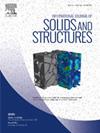Different mechanical models for the study of ultrasonic wave dispersion for mechanical characterization of construction materials
IF 3.4
3区 工程技术
Q1 MECHANICS
International Journal of Solids and Structures
Pub Date : 2025-03-31
DOI:10.1016/j.ijsolstr.2025.113352
引用次数: 0
Abstract
It is well known from the literature that the phase velocity of waves is directly correlated with the stiffness of the material; however, experimental practice shows that this velocity changes significantly with varying frequencies, despite the fact that the elastic modulus of the material is, by definition, a material constant. We explore the dependence on the frequency of longitudinal ultrasonic plane waves velocity in construction materials, both from experimental and modeling points of view. For the sake of simplicity, the dispersive features are modeled by considering the case of a 1D medium, and two different kinds of mechanical models capable of describing wave dispersion phenomena are employed: a non-dissipative strain-gradient elastic model, and a dissipative viscoelastic one. In both cases, by using the extended Rayleigh–Hamilton principle, we derive the governing equations for 1D bulk waves propagation; in particular, in the case of the dissipative viscoelastic model either classical linear damping or Kelvin–Voigt damping is considered. The comparison of theoretical results with experimental findings obtained by ultrasonic tests on natural (sandstone) and artificial (concrete) construction materials shows that both theoretical models can satisfactorily describe the experimental behavior. These results encourage further experimental investigations for a clear and quantitative identification of the model that can be better used for engineering purposes.
不同力学模型研究超声波色散对建筑材料力学特性的影响
从文献可知,波的相速度与材料的刚度直接相关;然而,实验实践表明,尽管材料的弹性模量根据定义是一个材料常数,但该速度随着频率的变化而显著变化。本文从实验和模型两方面探讨了建筑材料中纵向超声平面波速度对频率的依赖关系。为简单起见,考虑一维介质的情况来模拟色散特征,并采用两种不同的能够描述波色散现象的力学模型:非耗散应变梯度弹性模型和耗散粘弹性模型。在这两种情况下,利用扩展的瑞利-汉密尔顿原理,我们推导了一维体波传播的控制方程;特别是,在耗散粘弹性模型中,要么考虑经典线性阻尼,要么考虑开尔文-沃伊特阻尼。通过对天然(砂岩)和人工(混凝土)建筑材料超声试验结果的比较,表明两种理论模型都能很好地描述试验行为。这些结果鼓励进一步的实验研究,以明确和定量的识别模型,可以更好地用于工程目的。
本文章由计算机程序翻译,如有差异,请以英文原文为准。
求助全文
约1分钟内获得全文
求助全文
来源期刊
CiteScore
6.70
自引率
8.30%
发文量
405
审稿时长
70 days
期刊介绍:
The International Journal of Solids and Structures has as its objective the publication and dissemination of original research in Mechanics of Solids and Structures as a field of Applied Science and Engineering. It fosters thus the exchange of ideas among workers in different parts of the world and also among workers who emphasize different aspects of the foundations and applications of the field.
Standing as it does at the cross-roads of Materials Science, Life Sciences, Mathematics, Physics and Engineering Design, the Mechanics of Solids and Structures is experiencing considerable growth as a result of recent technological advances. The Journal, by providing an international medium of communication, is encouraging this growth and is encompassing all aspects of the field from the more classical problems of structural analysis to mechanics of solids continually interacting with other media and including fracture, flow, wave propagation, heat transfer, thermal effects in solids, optimum design methods, model analysis, structural topology and numerical techniques. Interest extends to both inorganic and organic solids and structures.

 求助内容:
求助内容: 应助结果提醒方式:
应助结果提醒方式:


